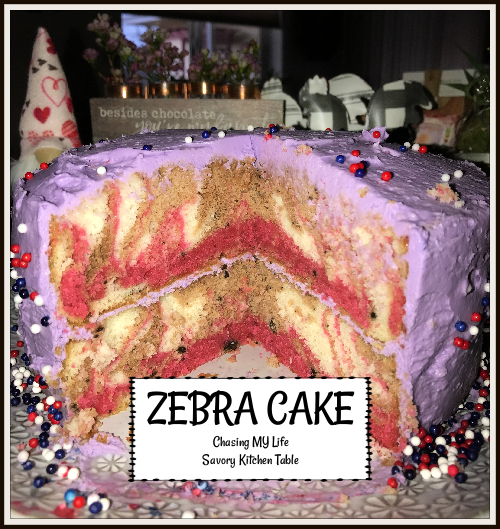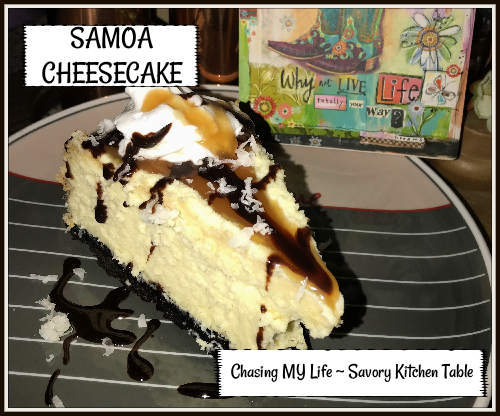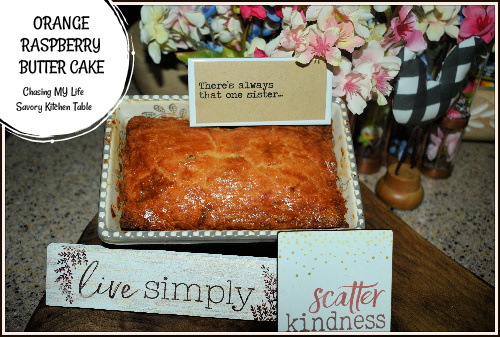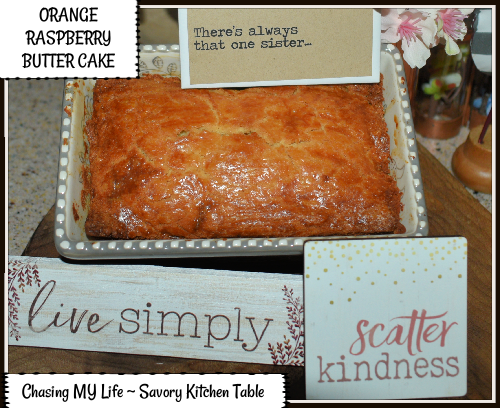While this recipe didn’t turn out exactly as planned, the flavor was amazing so we will be trying again for a better stripe and a better picture. 😀

ZEBRA CAKE
VANILLA LAYER
2 ¾ cups cake flour
2 cups granulated sugar
1 tablespoon baking powder
1 teaspoon salt
6 tablespoons unsalted butter softened to room temperature
⅔ cup avocado oil
¾ cup whole milk, room temperature
½ cup sour cream
1 tablespoon clear vanilla extract
6 LARGE or EXTRA LARGE egg whites, room temperature
- In a stand mixer sift together flour, sugar, baking powder, and salt until thoroughly combined.
- Turn your mixer to low speed and add butter, one tablespoon at a time, not adding the next tablespoon until the first is completely incorporated. When you’re finished, the mixture should resemble coarse sandy crumbs.
- Add oil and stir until combined.
- In a measuring cup, whisk together milk, sour cream, and vanilla extract and stir into batter until thoroughly incorporated.
- In a separate clean, dry, chilled and grease-free bowl use clean beaters to beat egg whites to stiff peaks.
- Use a spatula to gently fold egg whites into batter – DO NOT OVER MIX, but make sure there are no lumps of egg white remaining either.
- Portion 3 cups of batter into a separate bowl. You’ll be left with 5 cups in the first bowl that will be used to make into the chocolate batter.
CHOCOLATE LAYER
scant ¼ cup dark cocoa powder
2 tablespoons boiling water
2 tablespoons sour cream
2 tablespoons granulated sugar
- In a large measuring cup, stir together hot water and cocoa powder – it will be thick!
- Add sour cream and sugar, whisking until well combined.
- Stir into the smaller bowl of batter and use a spatula to carefully stir together until completely combined
BAKING ASSEMBLY
- Preheat your oven to 350°.
- Prepare two 8 inch round cake pans AT LEAST 2” deep by lining each of the bottoms with a round of parchment paper and generously spraying the sides with baking spray.
- Dollop approximately ⅓ cup of white batter into the center of each of your prepared cake pans.
- Using a clean scoop, scoop just shy of ⅓ cup of chocolate batter and drop that directly onto the center of the white batter.
- Repeat, alternating batter flavors, until you have used all of the batter.
- Take a reasonable amount of care so that your white batter doesn’t touch another ring of white batter nor does a ring of chocolate overlap with any of the other chocolate batter, this will keep your stripes looking like stripes and not like marbled swirls.
- Carefully transfer pans to oven and bake for 35-40 minutes or until a toothpick inserted in the center comes out clean or with moist crumbs.
- Allow to cool in pans for 15 minutes then run a knife around the edges of the cake to loosen from the sides (if needed) and carefully invert onto a cooling rack to cool completely.
- If needed, carefully level the cakes with a sharp serrated knife once completely cooled.
- Decorate.
NOTES:
- THIRD STRIPE If you would like a 3rd color stripe make a half batch of the vanilla cake and add food coloring accordingly. You’ll also need to use 9 inch pans. If making it a red strip I use a half portion of my red velvet cake recipe.
- CAKE FLOUR I recommend cake flour for two reasons with this cake: 1) it has a lighter texture and when you use all-purpose flour the cake ends up a bit heavier and tends to sink in on itself a little bit. 2) it produces a finer crumb, which makes the stripes even bolder and more defined.
- VANILLA EXTRACT you may substitute regular vanilla extract, but clear extract helps to keep the cake batter pure white.
- COCOA POWDER I use “special dark” cocoa powder because it makes the zebra stripes darker and closer to black, but you may substitute natural cocoa powder.
RED VELVET CAKE
2 1/2 cups all purpose flour
1 1/2 cups sugar
1 teaspoon baking soda
1 teaspoon fine sea salt
1 teaspoon QUALITY cocoa powder
1 1/2 cups avocado oil
1 cup buttermilk, room temperature
2 LARGE eggs, at room temperature
2 tablespoons QUALITY red food coloring
1 teaspoon white distilled vinegar
1 teaspoon PURE vanilla extract
- Preheat the oven to 350°.
- Lightly oil and flour three 9 by 1 1/2-inch round cake pans.
- In a large bowl, sift together the flour, sugar, baking soda, salt, and cocoa powder.
- In another large bowl, whisk together the oil, buttermilk, eggs, food coloring, vinegar, and vanilla.
- Using a standing mixer, mix the dry ingredients into the wet ingredients until just combined and a smooth batter is formed.
- Divide the cake batter evenly among the prepared cake pans.
- Place the pans in the oven evenly spaced apart.
- Bake, rotating the pans halfway through the cooking, until the cake pulls away from the side of the pans, and a toothpick inserted in the center of the cakes comes out clean, about 30 minutes.
- Remove the cakes from the oven and run a knife around the edges to loosen them from the sides of the pans.
- Invert the cakes onto a plate and then re-invert them onto a cooling rack, rounded-sides up. Let cool completely.
FINAL ASSEMBLY
- Place 1st layer, rounded-side down, in the middle of a rotating cake stand.
- Using a palette knife or offset spatula spread 1/4 to 1/2 inch layer of the frosting over the top of the cake.
- Carefully set second layer on top, rounded-side down, and repeat.
SWISS MERINGUE BUTTERCREAM (not as sweet as an American buttercream)
Yield: 5 cups
Swiss Meringue Buttercream is not as sweet as American buttercream which makes it PURE perfection in my book because it’s the ideal balance of sweet AND creamy, without being as sugary as American buttercream, but still as thick and pipe-able.
6 LARGE FRESH egg whites (approximately 230g)
2 cups (400g) granulated sugar
1 and 1/2 cups (3 sticks; 350g) unsalted butter, cut into tablespoon sized pieces and softened but still cool *see note*
2 teaspoons PURE vanilla extract
1/8 teaspoon salt
- Separate the eggs one at a time into a small bowl before placing them in a heat proof bowl.
- Whisk sugar into the egg whites, then set the bowl over a saucepan filled with just two inches of simmering water over medium heat. Do not let the bottom of the egg whites bowl touch the water.
- Whisk the egg whites and sugar together 4-5 minutes until sugar is COMPLETELY dissolved and the mixture has thinned out. (The mixture will be thick and tacky at first and then thin out and be frothy white on top.) To test that it’s ready, use your finger. Lightly and quickly dip your finger into the mixture (BE CAREFUL it will be very hot) and rub the mixture between your thumb and finger. You shouldn’t feel any sugar granules. OR use an instant read thermometer – the temperature should read 160°F (71°C).
- Transfer mixture to the bowl of a stand mixer fitted with a whisk attachment while it’s still warm.
- Beat on medium high speed 10-15 minutes until stiff glossy peaks form and the meringue is no longer warm to the touch. This will take a few minutes more on particularly humid days. MOISTURE IN THE MAKES A DIFFERENCE. If it’s still not reaching stiff peaks, stop the mixer, place the uncovered bowl in the refrigerator for 10 minutes, then return to the mixer and continue beating until stiff peaks form and the mixture has cooled to room temperature. You can put it in the refrigerator for a couple minutes if needed. If it’s too warm, the butter will melt instead of blend.
- Switch to the paddle attachment.
- On medium-high speed, add the butter 1 tablespoon at a time. Wait for the butter to fully mix in before adding the next tablespoon.
- Add the vanilla, salt and flavor if using beating 30 seconds until completely incorporated. It should be thick, creamy and silky smooth.
NOTES
TROUBLESHOOTING TOO THICK If the meringue has separated, curdled, or is too thick at any point after you mix in all of the butter, place the mixture in your heat-proof bowl back over a pot of 2 inches of simmering water – DO NOT STIR. Let the edges of the meringue warm up 1-2 minutes and become liquid while the center of the meringue is still be solid. Remove from heat and return to the mixer. Beat meringue on low speed for 30 seconds, then switch to medium-high speed and beat until smooth, about 2 minutes.
TROUBLESHOOTING TOO THIN If the meringue becomes too thin after you add the butter, place the entire bowl in the refrigerator for no more than 20 minutes at a time (any longer will make the butter solid) to cool down. Return it to the mixer and beat on medium-high speed until thickened. If it’s still soupy, place back in the refrigerator again before re-whipping again.
EGG WHITES For best success use FRESH eggs. FUN FACT – eggs separate much easier when they’re cold. Be sure and separate the egg whites one at a time into a small bowl and then place the egg white into a large heat-proof mixing bowl, double boiler or the metal mixing bowl from your stand mixer before separating the next. This way, if a yolk breaks in one of them, you don’t waste the whole batch.
BUTTER This buttercream will become liquid-y (too thin) if the butter is too warm. Make sure you’re using butter that is slightly cooler than proper room temperature butter. Remove butter from the refrigerator and set it out for just 30-40 minutes before you need to add it to the meringue.
FLAVORS adding flavors can be tricky. Substituting extracts for the vanilla is one of the most fool proof ways. Or even a teaspoon of espresso powder or frozen fruit powder. Taste, then add a touch more if desired. For potent extracts, like peppermint or almond use just 1/2 teaspoon. For chocolate, beat 8 ounces of PURE (like Baker’s OR Ghiradelli) melted and slightly cooled chocolate of choice into the buttercream at the same time you add the vanilla and salt.
COLORS If you are coloring use gel food coloring so it does not add any liquid.
HALVING OR DOUBLING If you halve the recipe the time to reach stiff peaks and cook time will be less. I DO NOT recommend doubling this recipe. If you need a double recipe make it in separate batches so you don’t overcrowd the bowls.
OR
CREAM CHEESE FROSTING
16 ounces cream cheese, softened
1/2 cup butter, softened
juice of 1 LARGE lemon
2 teaspoons PURE vanilla extract
3-4 cups powdered sugar
- In a medium bowl beat cream cheese and butter until smooth.
- Add lemon juice and vanilla. Beat until blended.
- Add powdered sugar gradually until well blended and smooth and you reach desired consistency.
- Ice first layer and then add 2nd cake top and ice again including sides of cake.
- Refrigerate 1 hour to set icing before serving.




















